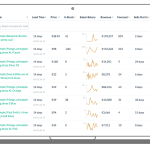Bringing Sexy to Business Software from Ordoro on Vimeo.
A few months back, our Design Director Matt Omohundro gave a talk during NewCo ATX about how Ordoro goes about – you guessed it – designing a sexy UI/UX that matches customer expectations and gets them cranking through their daily back office grind. A video of the presentation is above for your viewing pleasure.
And if you’re more of a reader, we also spoke to him on his process, his thoughts, differences between marketing design and UX/UI, and more below.
How do you go about beginning to design?
It always starts the same, and that’s with my sketchbook. Good design starts with a good idea, which means not being held up by making something look perfect right off the bat. And that’s a big challenge for someone working in the visual realm. The key thing with my job is everyone can see what I do and can comment on it, and sometimes it takes a lot of time behind-the-scenes to make something look average. But I always start in my sketchbook – it’s about listing out ideas and rough sketches – so it always begins and evolves from there.
Some say that nothing is ever original when it comes to creating or designing things. What do you think about that?
Many famous designers say “everything’s already been designed” and I agree with that to a certain extent. It’s up to the designer to either make it their own and fit their specific need, or (more importantly) make it better. Sometimes you can revolutionize stuff and change the way a common thing is. You can take from a variety of sources and turn something that’s been around into your own.
What are the main differences between dealing with marketing materials vs. the UX/UI?
The thing with working on the UX is that it’s a process for every little thing that goes into the app. Not only thinking about it, but also seeing how people will react to it. Nothing is finished, ever. Our app is always changing. It’s the perpetual work in progress. And the reason is because existing users and new users are always coming in with different things they need.
That’s what’s different. The UX/UI is always in limbo and it must evolve and change, unlike the marketing stuff (which can be cranked out pretty quickly). And the research for the UX/UI is the most important part. I need all the data and feedback from the support team, and the big vision for the app from the business-side folks in order to create something that’s usable. My job is about facilitating a great experience by letting go of my own personal biases, executing the plan (that’s been well-informed and researched), and making the users as happy as possible.
Although it’s separate (sort of like a left brain, right brain kind of thing), I always try and keep the marketing design work in mind with the UX design work. Because I have a deep understanding of the brand, it’s fun to try and incorporate that vibe into the app for a seamless experience. It’s not like a marketing agency did our marketing side, and you go to the app and an in-house team did that, so it looks and feels different. The brand is reflected in both our marketing and our product.
Are there any design tactics you use to cater towards ecommerce merchants?
Legibility and scan-ability are two of the most important things I focus on. I’m constantly asking myself “how do we make sure our users don’t feel like they’re stuck in an Excel spreadsheet?” They need to be able to quickly parse through some dense shipping info. You could do the same stuff in Excel, but our system allows you to do these mundane tasks faster, easier and less stressful. I think a lot of that can be attributed to keeping things clean and simple.
Furthermore, lots of our customers sell their goods on e-commerce platforms like Shopify and Bigcommerce, both of which boast slick interfaces for their admin sections. High-end interface design for business applications are what people are getting more and more used to, and it’s essential that we try and keep up with that.
On that note, since Ordoro is all about multichannel retailers, does the app have to reflect other apps? Does that restrict it?
We’re heavily reliant on what other bigger ecommerce companies are doing with pushing the boundaries, but we have to be careful. Do you remember that social app called Path? The UI was gorgeous and minimal, but it flopped in the US partially because it was almost too simple and it had limited features. Although it looked much cooler, I think it was too radical a departure from what people were used to with Facebook. We want to try radical and crazy (to an extent) with our interface, but at the same time don’t want to alienate users.
Above all, we know we’re a business app – people use us to get their stuff done – so we can’t go too buck wild and must respect that fact. Change aversion and technological limitations are real things with customers (especially those working in warehouses), so we have to tread lightly in that regard. The good thing is that keeping tabs on what ecommerce big dogs are doing helps us gauge how far we can go.
What do you enjoy most about your job?
Aside from my awesome coworkers, what I love about this job is that I really feel I get to use all my experience from previous jobs. I’ve worked in advertising, journalism, social media and other software companies and it’s really awesome to use things I’ve learned from those previous experiences for my role at Ordoro.
Another thing I love since being here is learning how to create a product that’s built by the people that use it. We’re not siloed away – we’re as transparent as we can be with our customers, and we’ve got strong relationships across all the teams at Ordoro. I think our small size, all of us honing our skills and really caring about what the customer wants in all aspects of our product is something very unique and awesome. This is our baby that people are paying us to use, and we should make sure their voices are coming through on how they want to use it, and how they’d like it to be. This internal and external collaboration not only makes our app great, but it also strengthens our brand.


